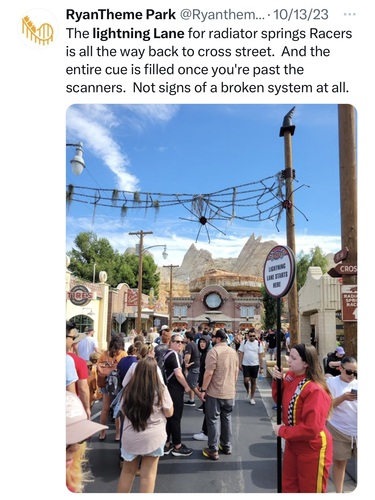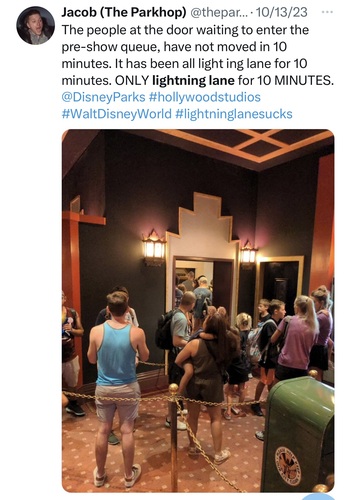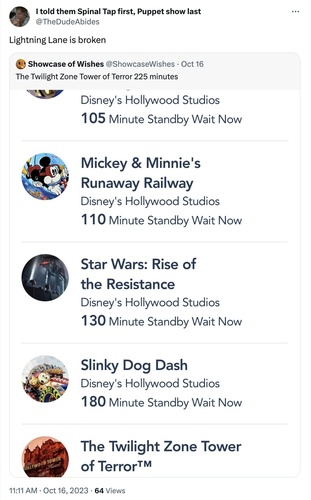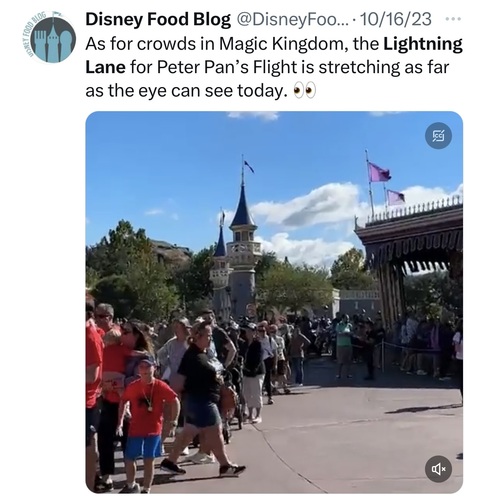Disney’s Lightning Lane paid line system has some fatal flaws, and guests are exposing them online. If more people refused to pay for Genie+, the problems would resolve.
Forget creativity, forget “magic” and “dreams,” forget Walt’s “vision.” The Disney brand of our day is built mostly on cash grabs.
Disney routinely hikes prices far past the rate of inflation despite well-documented maintenance and investment woes and yet still delivers an overcrowded park experience.
But Disney’s Genie+ line reservations system may be the most miserable and customer-hostile thing the company has ever done. It worsens the very problem it purports to solve.
For background—and if you know Disney well, you can skip this paragraph—the most popular Disney Parks attractions offer two lines. One is the “Standby Line,” and it’s what you’d think of as the “normal” line. You join, you wait for approximately the length of the posted time, and then you ride. A second line, Lightning Lane, is advertised by Disney as faster than the other. The speedier line used to be complimentary and called FastPass. But Disney turned that free service into a profit center, and now the only way to use it is to pay Disney another $18–$35 per person per day (the rate is usually at the high end of that scale), or in some cases, to pay a similar price for a single ride.
More and more, posts on social media are exposing Disney’s Lightning Lane program as so oversubscribed and/or poorly managed that the Lightning Lane queues are often many times longer than the free Standby queues.
On Tuesday, February 20, Disney site BlogMickey.com posted this incriminating video of the Lightning Lane line at one Fantasyland kiddie ride, Peter Pan’s Flight. It shows a long line of people snaking for long distances around wide expanses of Magic Kingdom park.
Does this look like a fun day to you?
The Peter Pan’s Flight Lightning Lane is insane. It starts in the walkway between Pan and small world, heads toward Carrousel, and then makes a u-turn before utilizing the intended extra queue past the tappoint
Genie+ sold out before park open, but that was probably too late pic.twitter.com/9Pf1wQVxaq
— BlogMickey.com (@Blog_Mickey) February 20, 2024
On the day that video was shot, Genie+ availability sold out even before the park opened to guests. That means every person in that line had voluntarily paid $29 extra to wait in that excruciating crowd, but only after they endured the frustration of pre-booking that wait, and that was on top of the inconvenience of getting up at dawn to subscribe for the right to do it to begin with—and that $29 per person was on top of admission. The levels of voluntary misery would repel Dante himself.
This issue is nothing new. On one social media site in late 2023, user @TheNobleWays documented just how many Lightning Lane guests were being admitted to one ride, Mickey & Minnie’s Runaway Railway, compared to guests who decided not to slip Disney the extra cash.
The video shows continuous footage of a Disney crew member at what’s called a merge point—the spot where an attraction’s two line types, paid Lightning Lane and free Standby, come together and staff decides how many people in each queue to admit to the final leg of the line.
The video’s owner counts as no fewer than 100 Lightning Lane guests are allowed to speed through the merge point while nonpaying guests have to wait. A hundred!
Then the clip counts off how many Standby guests are allowed in before that line is cut off to admit more Lightning Lane guests. Only 15 Standby customers are allowed through at a time.
The video suggests that Disney’s line system is now so heavily weighted toward the up-charged option that 100 fee-paying guests are moved through the merge point for every 15 non-fee-paying guests.
The paid line is now the main line
It’s terrible math for consumers. If you don’t cough up extra money for Disney, you could be passed over 85% of the time.
But there’s a bigger problem. If Disney is overselling Lightning Lane to such a degree that a majority of visitors are now paying for the service, then, numerically speaking, Disney has turned Lightning Lane into the busiest, de facto main queue.
If that’s true, then Disney has tricked customers into paying another $30 a day just to wait in the main lines—something you could once do for free.
What’s worse, Lightning Lane gives Disney a financial incentive to post longer wait times, because guests now believe that buying access will help them get onto rides faster.
That’s pretty scammy.
Disney doesn’t release how many people are allowed to purchase Lightning Lane access each day, although there are plenty of third-party number-crunchers who use doctorate-level statistics skills to try to crack the math.
The company also doesn’t release the formulas used to determine how many paid Lightning Lane guests are admitted at a time compared to free Standby guests. (Materials provided to the media for reference don’t even explain the details of how Lightning Lane works—journalists like me have been forced to figure it out by trial and error instead.)
Still, we do know that on some days the parks have announced that Genie+ has sold out. Since Genie+ grants Lightning Lane availability, when Genie+ sells out, the parks abruptly end the day’s Lightning Lane sales—a sure sign that the system is over capacity.
Because so many Disney guests are paying for “faster” lines, those purchases actually ensure that the “fast” line is as busy as the old-fashioned free line used to be. The longest line could be the paid one.
If most of those Lightning Lane customers agreed not to give Disney the extra $30-or-so per person every day, then the Standby line would actually be the much swifter choice.
There are occasions when Lightning Lane truly is fast, but in many of the same cases, the Standby line was short enough to have sufficed, too.
Plenty of posts from eyewitnesses back up the claims of colossal mathematical issues with oversubscription to the Lightning Lane program at Disneyland Resort in California as well.

If an attraction has to close down for any length of time during operating hours—something that can happen multiple times a day on the most complex rides—then the customers who had planned to use Lightning Lane during that period invariably come swarming back as soon as the ride has reopened.
But when the Lightning Lane swells, Disney staffers are forced to limit the number of Standby customers at the merge point even more strictly in order to clear the crowds. And that makes the regular wait time inflate even higher.

Disney doesn’t promise customers that Lightning Lane lines are shorter, but the parks do tell guests that buying Lightning Lane access helps “save time in line.” That’s technically true, but it’s also clear that Standby would be faster if there were no Lightning Lane. Standby got slow because of Lightning Lane—the “cure” causes the disease.

When Standby wait times stretch to those lengths, more guests cave and pay for Lightning Lane, deepening the spiral.
Disney has created a situation in which ride breakdowns can actually make the parks more money. The more rides shut down, the more Standby wait times go up, and the more people purchase Lightning Lane, thinking it will solve their need for speed.
Even after paying that $30 per person for Genie+, most guests are still only likely to use Lightning Lane 2 or 3 times over the course of the whole day—and that’s using Disney’s own estimate, which is buried in the fine print! That breaks down to about $10 per ride.
If the current leaders of the Walt Disney Company believe these guest experiences won’t bounce back on them, they’re as deluded as they are money-hungry. Longtime fans are bailing on Disney, and a significant portion of the people who are stuck paying for those ridiculous, money-tapping lines end their days at the park by walking out of Disney’s front gates swearing they won’t return for a long time. (Are you one of them?)
It’s just one of the reasons why in January 2024, a Casino.org poll named Walt Disney World as the biggest rip-off in the United States. And if a casino website is calling you a rip-off, it’s time for some introspection.

It doesn’t have to be this way
Disney’s parks weren’t always this overcrowded. Just look at this aerial footage of EPCOT shot in the 1980s. There was plenty of elbow room; the experience looks pleasant and dignified. At the time this film was shot, EPCOT was one of the most famous theme parks in the world. Yet it still wasn’t overstuffed. But on some other day, we can talk more about the many disastrous managerial decisions and the heedless drive for corporate synergy that caused Disney parks to be as over-promoted, overcrowded, and overpriced as they are today.
Will Disney do the honorable thing and halt or dramatically curtail sales of Lightning Lane? That’s highly unlikely. The company needs money, and the parks division is one of the only parts of the company that’s rolling in cash, thanks to unquestioning vacationers.
Per-guest spending has shot up by more than 20% in the past two years, and Genie+ (which visitors must purchase to access most Lightning Lanes) is a huge part of that revenue.
It’s pretty obvious that Disney’s Lightning Lane cash grab idea is broken. It hustles families into paying hundreds extra to do something that used to cost nothing. Every time a customer decides to pay into the system, the problem only gets worse.
The Disney of the 2020s is a much more venal entity than the customer-first boutique empire that Walt grew, and the more guests reward that greed, the worse the Disney experience gets.
If everyone abandoned Lightning Lane, then the Standby line would move faster than anything else.
Until then, Disney guests are pouring funds into the company’s pockets for something they should—and did—have for free.
Jason Cochran is the author of our award-winning Frommer’s Disney World, Universal & Orlando guide book.